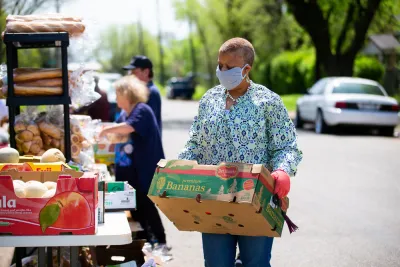A study from Des Moines found that households in historically redlined parts of town are more likely to have to seek help from food pantries.

An article by Linh Ta on Axios highlights the persistent negative impacts of redlining on American communities, citing a recent study from the Des Moines Area Religious Council that finds that households in that city’s historically redlined district are most likely to experience food insecurity.
“The redlined neighborhoods that lacked investment 90 years ago — many of which are on the city's south and east sides — are still suffering from economic instability and lower home ownership rates, according to DMARC.” Some of these areas are also at the highest risk for flooding, the report noted.
“Out of all the food pantry users in the Des Moines metro, about 43% of them live in a former C or D district, said Luke Elzinga, spokesperson for DMARC.” Homes classified as C or D properties were deemed “high risk” for lending. According to the report, “55% of multi-race Hispanic families that visited DMARC's food pantries lived in one of those districts compared to just 38% of white food pantry users.” Elzinga pointed to the need for support in multiple areas to reduce food insecurity among low-income households. “Factors like improving affordable housing options and childcare factor into economic stability.”
FULL STORY: Struggles continue in Des Moines' redlined district

National Parks Layoffs Will Cause Communities to Lose Billions
Thousands of essential park workers were laid off this week, just before the busy spring break season.

Retro-silient?: America’s First “Eco-burb,” The Woodlands Turns 50
A master-planned community north of Houston offers lessons on green infrastructure and resilient design, but falls short of its founder’s lofty affordability and walkability goals.

Delivering for America Plan Will Downgrade Mail Service in at Least 49.5 Percent of Zip Codes
Republican and Democrat lawmakers criticize the plan for its disproportionate negative impact on rural communities.

Test News Post 1
This is a summary

Test News Headline 46
Test for the image on the front page.

Balancing Bombs and Butterflies: How the National Guard Protects a Rare Species
The National Guard at Fort Indiantown Gap uses GIS technology and land management strategies to balance military training with conservation efforts, ensuring the survival of the rare eastern regal fritillary butterfly.
Urban Design for Planners 1: Software Tools
This six-course series explores essential urban design concepts using open source software and equips planners with the tools they need to participate fully in the urban design process.
Planning for Universal Design
Learn the tools for implementing Universal Design in planning regulations.
EMC Planning Group, Inc.
Planetizen
Planetizen
Mpact (formerly Rail~Volution)
Great Falls Development Authority, Inc.
HUDs Office of Policy Development and Research
NYU Wagner Graduate School of Public Service





























